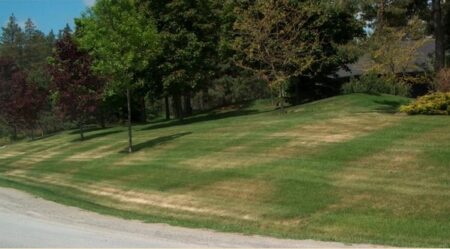 The month of June has many homeowners seeking to improve the look of their properties as everything is growing fast and filling in. They mostly ask about the best lawn cutting practices and how to tend to their plantings as the weather heats up and the pests emerge.
The month of June has many homeowners seeking to improve the look of their properties as everything is growing fast and filling in. They mostly ask about the best lawn cutting practices and how to tend to their plantings as the weather heats up and the pests emerge.
Below we will highlight the most basic tasks any homeowner can perform to ensure the long life of their plants and a healthy turf. ~Shayne
LAWN MOWING 101
For a healthy and lush lawn we recommend that mowing follows these basic guidelines.
- SAFETY FIRST! Make sure your mower is in peak working order, walk the property to remove rocks, twigs, etc. and always wear eye protection and sturdy footwear.
- Know how to properly operate your lawnmower and are familiar with all the settings – especially the emergency shut off.
- Keep your grass a little longer in the hot summer months to shade the soil and help it retain precious water lost by evaporation.
- Only remove the top ⅓ of the grass at a time to avoid stressing it which invites diseases.
- Allow grass clippings to remain on the lawn to decompose and fertilize the soil or add them to your compost.
- Do not mow wet grass.
- Keep your mower blades sharp.
- Change up your mowing pattern to encourage the grass to grow straight.
- Call us if you are experiencing any issues.

CHINCH BUGS
 Chinch bugs are tiny bugs that live in your lawn and can cause costly damage when not identified and treated. They feed on healthy grass causing dry brown patches in the turf and can spread quickly if left unchecked.Because chinch bugs are most active in the hot and dry summer months and thrive in those conditions, it is important to identify what is causing any brown spots because drought stress can look very similar.The easiest method to detect chinch bugs is to simply pull up some of the brown turf at the point it meets healthy turf and look for them. A healthy lawn can defend itself against some chinch bugs and they can be present in any lawn, but a problem begins when their populations exceed tolerable levels.Proper mowing, watering, and fertilization are key in keeping your grass healthy and to help it fight disease and deter these and other pests.Please let us know if you need help in identifying any issues in your turfgrass or if you’re concerned about the number of chinch bugs you see.
Chinch bugs are tiny bugs that live in your lawn and can cause costly damage when not identified and treated. They feed on healthy grass causing dry brown patches in the turf and can spread quickly if left unchecked.Because chinch bugs are most active in the hot and dry summer months and thrive in those conditions, it is important to identify what is causing any brown spots because drought stress can look very similar.The easiest method to detect chinch bugs is to simply pull up some of the brown turf at the point it meets healthy turf and look for them. A healthy lawn can defend itself against some chinch bugs and they can be present in any lawn, but a problem begins when their populations exceed tolerable levels.Proper mowing, watering, and fertilization are key in keeping your grass healthy and to help it fight disease and deter these and other pests.Please let us know if you need help in identifying any issues in your turfgrass or if you’re concerned about the number of chinch bugs you see.
DROUGHT STRESS
With below normal rainfall this spring, the lack of snow cover last winter, limited recent rainfall, and rising temperatures, we are now experiencing “very dry conditions” throughout Litchfield and Fairfield counties. Let’s hope that we do not move into a serious or long-term drought.
While damage from pets, pests or diseases typically affect select patches of turf, drought stress will yellow the lawn more evenly as shown below. Strong and healthy grass will fight off drought somewhat and you’ll want to follow the above mowing tips to help keep any stresses at bay. If your lawn is turning yellow from drought stress, it is not dying, it’s just going dormant for self-preservation and can stay this way for many weeks! Once the rains return, the grass will bounce back.
To help your lawn before and during times of drought, implement the following practices whenever possible:
- Water your lawn in the morning and try to keep the amount of water you use to the minimum amount the grass needs since we are approaching drought conditions.
- Mow high!
- Stay off drought stressed grass to avoid further damage.
- Do not overwater.
- Dethatch if needed to allow precious water to reach the soil.
Don’t forget your container plants during dry conditions! These may need to be hand watered every few days to keep them blooming all season.
We have a very talented and hardworking team that strive to ensure your properties are looking their best and they love to receive your feedback!
We always welcome your comments and post them in the crew room and website for all to see! As mentioned in a previous ScapeMail, we also factor in any feedback while calculating each ‘Scaper of the Month award and the highly prized ‘Scaper of the Year award.
You can call us, give your feedback to your landscape consultant, or email us HERE. Don’t worry if you don’t know their names, we know who they are!






